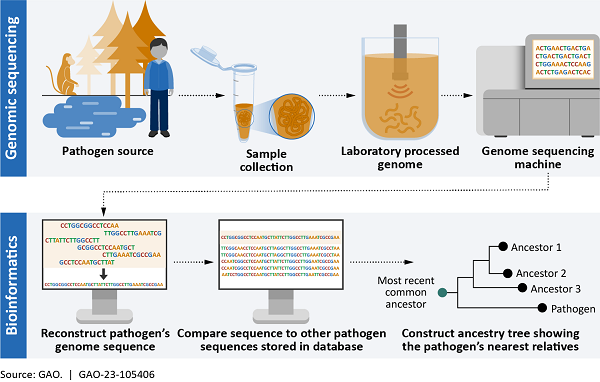Pandemic Origins: Technologies and Challenges for Biological Investigations
Fast Facts
Pandemics have high health and economic costs. Understanding their origins can help policymakers craft responses to prevent future pandemics.
Several technologies can help researchers discover a pandemic's origin, such as using genetic analysis and disease tracking. These investigations can be slow, but the technologies aren't the problem. For example, delays can result when investigators can't access biological samples, or if there aren't enough trained investigators.
We identified five policy options to address these issues, such as establishing agreements for biological sample sharing and expanding the pandemic origin investigator workforce.

Highlights
What GAO Found
Determining the likely origin of pandemics is challenging. Researchers may use several technologies to investigate a pandemic’s origin. For example, researchers use technologies such as genomic sequencing, bioinformatics analysis, and genetic databases to generate, analyze, and compare a pathogen’s genetic makeup against that of other pathogens. A key limitation of these technologies is that some laboratory-based genetic modifications may be indistinguishable from natural variations. Access to samples is critical for conducting genetic sequence analysis, which allows researchers to generate and analyze the data needed to support the likely origin of a pandemic.
Examples of technologies for pandemic origin investigations

Researchers also use technologies such as serology (i.e., blood analysis) and epidemiological surveillance—tracking a disease as it moves through a population—to monitor pathogen infection and disease occurrence in human and animal populations. The resulting data can support pandemic origin investigations. However, for these technologies to be effective in determining a pandemic’s likely origin, investigators need access to samples and data from infected or exposed individuals from early in an outbreak to reliably trace the disease back to the first human infection(s). Further, researchers may conduct laboratory-based pathogen studies to generate data to support known natural patterns or unusual patterns of spread indicative of a possible laboratory-related origin. However, some pathogens cannot be easily cultured in a laboratory setting, and some pathogens may require enhanced biosafety-level facilities.
However, experts told GAO that technologies are not the limiting factor for determining the likely origin of a pandemic. GAO identified three cross-cutting challenges that hinder pandemic origin investigations. These include a lack of sufficient access to samples and genetic sequence data; a lack of standardized processes for submitting, accessing, and using genetic sequence data stored in databases around the world; and a lack of a sufficient and skilled interdisciplinary workforce.
GAO identified five policy options that may help address the cross-cutting challenges. These policy options represent possible actions that policymakers—who may include Congress, federal agencies, state and local governments, academia, industry, and international organizations—could consider taking. See below for a summary of the policy options and relevant opportunities and considerations.
Policy Options to Address Three Cross-Cutting Challenges in Pandemic Origin Investigations
| Policy Option | Opportunities | Considerations |
|---|---|---|
|
Establish multilateral agreements for accessing and sharing samples and genetic sequence data (report p. 21)
|
|
|
|
Develop standardized processes for genetic sequence database use (report p. 22)
|
|
|
|
Improve current, or develop new, genetic sequence database tools (report p. 23)
|
|
|
|
Encourage the development, retention, and growth of a workforce with the critical skills needed for pandemic origin investigations (report p. 24)
|
|
|
|
Augment or develop a national strategy to better coordinate and collaborate domestically and internationally on pandemic origin investigations (report p. 25)
|
|
|
Source: GAO. | GAO-23-105406
Why GAO Did This Study
Pandemics are global disease outbreaks that can greatly increase morbidity and mortality and cause significant economic and social disruptions. According to the scientific literature, most pandemics where the origin is known were caused by the natural transmission of a virus through animal-to-human contact; however, there is potential for a pandemic to originate from laboratory research.
GAO was asked to conduct a technology assessment on pandemic origins. This report describes: (1) key technologies available for pandemic origin investigations, (2) strengths and limitations of these tools and how researchers use them to investigate pandemic origins, and (3) cross-cutting challenges researchers face in trying to determine a pandemic’s origin.
GAO reviewed peer-reviewed scientific literature and other documents, including reports from the Centers for Disease Control and Prevention, Office of Director of National Intelligence, Johns Hopkins Center for Health Security, World Health Organization, and select national laboratories; interviewed government, industry, and academic representatives; and convened a meeting of 27 experts in March 2022 with assistance from the National Academies of Sciences, Engineering, and Medicine.
GAO is identifying policy options in this report.
For more information, contact Karen L. Howard at (202) 512-6888 or howardk@gao.gov.
